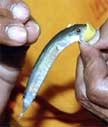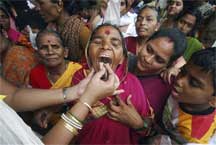Bathini fish medicine, available in the
southern Indian city of Hyderabad. The therapy is conducted every
year on the auspicious Mrigashira Karthi day of the Hindus,
which falls between June 6-8. The takers are asthmatics-young, old,
toddlers and invalids.
Started by the Bathini Goud family, the therapy has
been a secret for the past 156 years. It was given to Veeranna Goud,
a toddy vendor, over a century back by a holy man who instructed him
to give this free to everybody suffering from asthma. The holy man
also blessed a well in the place where the medicine is administered
- Doodhbowli, a mile or so away from the historic monument of
Charminar in Hyderabad. Only the Goud family knows what goes in the
herbal paste. The blessed well in their compound provides water for
the mixing of the medicine. At present, three Goud brothers carry
out the treatment, strictly in accordance with the practice of their
ancestors. Even today, they don't charge or accept any money for the
medicine. Instead, they pay for all the expenses from their own
pocket.
There is now an abundance of volunteers in the family who have
mastered the technique of administering live fish into the mouths of
fearful patients. Die-hard vegetarians can swallow bananas with the
paste instead, but the Gouds emphasize the importance of fish. As
the fish moves down the windpipe, it opens pores blocked by phlegm,
thus making way for the herbal paste. The procedure is simple. Once
the patient has swallowed the live fish, three doses of extra
medicine is provided, to be taken on three successive auspicious
days - Arudra Karthi, Punarvasu Karthi and Pushyami
Karthi, which fall every 15 days in a regulated span of 45 days.
Apart from this, the patient has to be under strict diet control for
45 days. The diet is probably harder to swallow than the live fish.
You literally have to practice being a martinet. With only a handful
of edibles allowed, patients labor through rigorous self-control,
abstaining from everything except the food items prescribed. Says
Harinath Goud, one of the three Goud brothers: "Unless you strictly
adhere to the diet, the effect of the medicine will not be optimum."
Besides, what is a period of a month and a half when weighed against
a life of breathless struggle? Every fortnight, morning and evening,
two pills made out of the paste are taken without fail with warm
water. The reason for the fortnightly gap is as much of a secret as
the medicine, yet it is religiously marked on every patient's
calendar. Life resumes normalcy on the 46th day. But cured? Well,
this is no one-time miracle. The Gouds state categorically that the
fish medicine has to be taken for three consecutive years. Says
 Sheela
Chakravorty, a patient: "The first time I took the fish, it was hard
to follow the diet. I was tempted to eat, not delicacies, but simple
things such as eggs and coffee, and maybe use a few spices that
weren't allowed. The next year, I was more relaxed and took it upon
myself to follow it through. And I did. Today, I am 75 per cent
cured."
Sheela
Chakravorty, a patient: "The first time I took the fish, it was hard
to follow the diet. I was tempted to eat, not delicacies, but simple
things such as eggs and coffee, and maybe use a few spices that
weren't allowed. The next year, I was more relaxed and took it upon
myself to follow it through. And I did. Today, I am 75 per cent
cured."
There are many such people who have struggled on the difficult path of
fish therapy and succeeded. Most notice an improvement in the first
year itself. But there's no fixed pattern to the treatment. There
are also some who feel no change. The reasons are plenty-perhaps the
diet was not followed properly or the asthma had gone far beyond
mortal help. Yet asthmatics from all over the country-and abroad -
converge at Hyderabad on the specified day to try out this
'wonder-therapy'. Skeptical doctors, many of whom hail from the
allopathic school of medicine, label the treatment illogical. Some
claim it to be nothing more than faith healing, where the
psychological state of the patient compels him to believe he can be,
and is being, cured. After all, a man who can't breathe is quite
desperate.
Others say the medicine has small quantities of cortisone mixed in
it, which gives relief from arduous breathing. But this has been
proven wrong as the medicine has been checked and certified by
pharmaceutical authorities in India as a purely herbal and
ayurvedic cure. Further, doctors who are more open to the idea
of age-old remedies and alternative therapies accept that, no matter
how skeptical you may be, the cure of thousands of patients year
after year is clear evidence of the therapy's effectiveness. I can
personally vouch for the efficacy of this treatment. A chronic
asthmatic, after taking the fish medicine I was not as sick even in
the dreaded month of July as I had been all these past years. A
break in the wheezing pattern that my lungs have followed for the
past 25 years cannot be written off as coincidental. I rather look
on it as a miracle of God and Goud alike.
As a direct consequence of the fish therapy's popularity, different
organizations have begun promoting similar cures in other parts of
India under the banner of 'Fish Medicine from Hyderabad'. Everything
is the same—the date, the yellow paste-like-medicine and the fish.
"But," says Harinath Goud, "there is nothing in common between them
and us. We don't divulge the secret ingredients of the medicine and
hence it is impossible for these cloning organizations to know what
goes into it." Skepticism and plagiarism notwithstanding, every year
in Hyderabad you see a motley crowd: the timorous, the confident and
the curious, standing in long serpentine queues before the blessed
compound of the Gouds. While some of them may lose interest in the
cure and not come again, others will simply thank the Lord, mark the
calendar for the following year, and go again for the big gulp!




 Sheela
Chakravorty, a patient: "The first time I took the fish, it was hard
to follow the diet. I was tempted to eat, not delicacies, but simple
things such as eggs and coffee, and maybe use a few spices that
weren't allowed. The next year, I was more relaxed and took it upon
myself to follow it through. And I did. Today, I am 75 per cent
cured."
Sheela
Chakravorty, a patient: "The first time I took the fish, it was hard
to follow the diet. I was tempted to eat, not delicacies, but simple
things such as eggs and coffee, and maybe use a few spices that
weren't allowed. The next year, I was more relaxed and took it upon
myself to follow it through. And I did. Today, I am 75 per cent
cured."